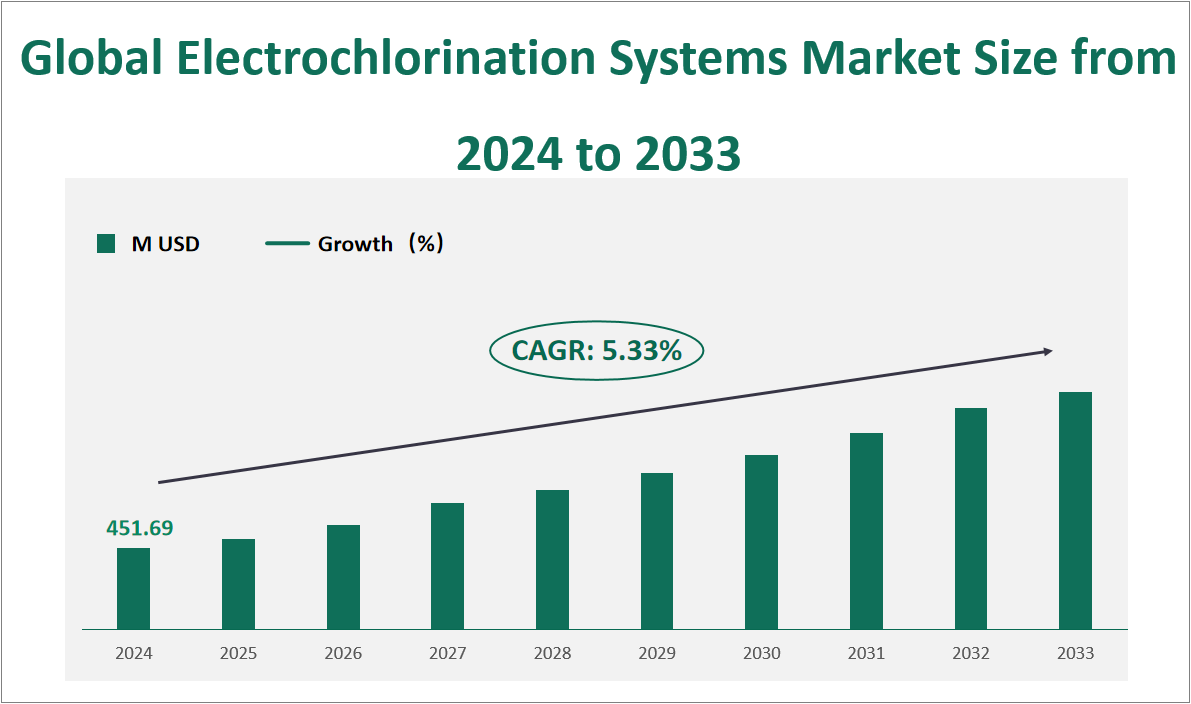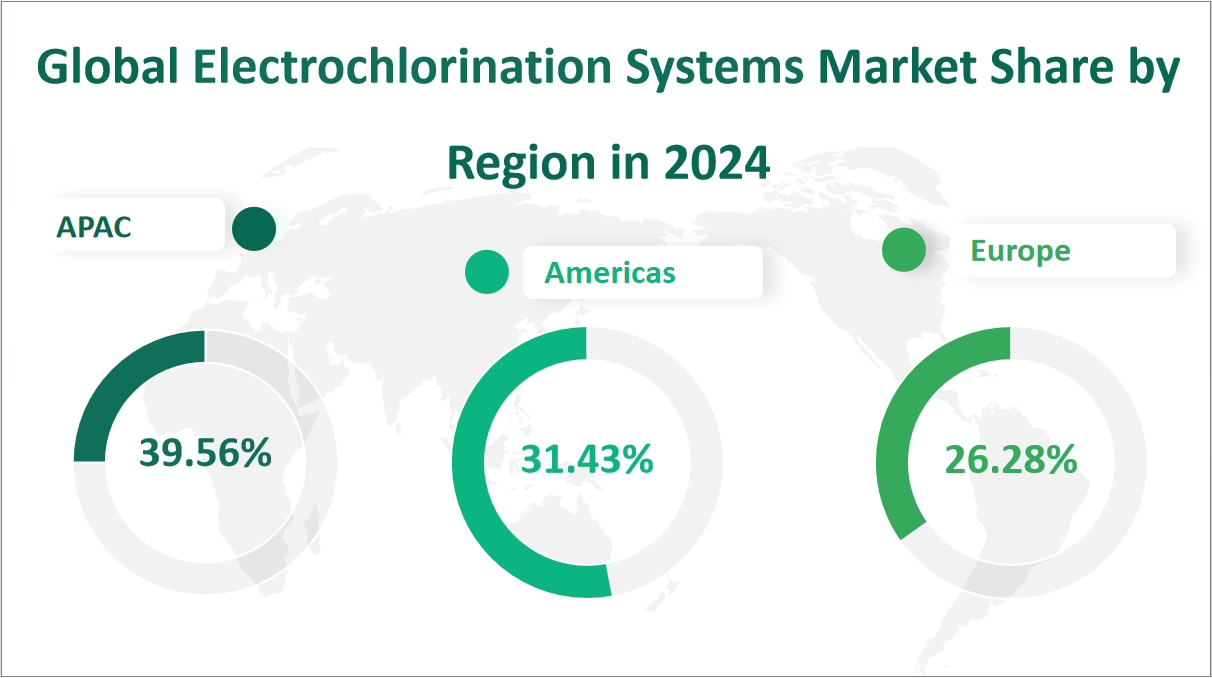1 Global Electrochlorination Systems Market Outlook
The global Electrochlorination Systems market is projected to exhibit substantial growth in the coming years, with a CAGR of 5.33% from 2024 to 2033, reaching a total market size of $451.69 million USD in 2024. Electrochlorination systems are designed to generate chlorine-based disinfectants on-site through the electrolysis of saltwater or brine. These systems offer a safer and more environmentally friendly alternative to traditional chlorine gas or liquid chlorine solutions. The generated sodium hypochlorite is used for water disinfection, biofouling control, and other applications in municipal water plants, marine vessels, and industrial facilities. The technology is particularly advantageous in regions with high water treatment demands and stringent environmental regulations.
Figure Global Electrochlorination Systems Market Size and Growth Rate (2024-2033)

2 Electrochlorination Systems Market Growth Drivers and Constraints
The growth of the electrochlorination systems market is influenced by several key factors. Growing demand from key regions such as Asia-Pacific, Europe, and the Americas is a significant driver. Countries like China and the United States are experiencing increased demand for water treatment solutions due to population growth, urbanization, and stricter environmental regulations. In Europe, the shift towards safer and more sustainable water treatment methods is also driving the adoption of electrochlorination systems.
Key applications such as municipal water treatment, marine, and industrial sectors are also fueling market growth. The need for effective disinfection in drinking water systems, the prevention of biofouling in marine vessels, and the treatment of industrial wastewater are all contributing to the increasing demand for these systems. Additionally, the COVID-19 pandemic has heightened awareness of water hygiene and sanitation, further boosting the market.
However, there are also limiting factors that could hinder market growth. High equipment costs remain a significant barrier, especially for small and medium-sized enterprises. The initial investment required for electrochlorination systems can be substantial, which may deter some potential buyers. Additionally, technical limitations such as the concentration of the produced sodium hypochlorite can restrict the applicability of these systems in certain industries. The need for continuous maintenance and the availability of skilled technicians are also challenges that need to be addressed.
3 Electrochlorination Systems Market Innovations and M&A Activities
The electrochlorination systems market is characterized by continuous technological innovation and strategic corporate activities. Companies are investing heavily in R&D to improve the efficiency and effectiveness of their systems. For example, De Nora has launched advanced electrochlorination systems such as ClorTec® and MIOX®, which offer significant operational cost savings and improved disinfection capabilities. Similarly, Evoqua Water Technologies LLC has introduced the Chloropac® system, which provides a safer and more efficient alternative for seawater disinfection.
Corporate mergers and acquisitions are also shaping the market landscape. For instance, De Nora acquired MIOX, enhancing its portfolio of water purification technologies. Evoqua Water Technologies LLC announced a majority investment in Frontier Water Systems, a pioneer in high-rate treatment and removal of contaminants from complex waste streams. These strategic moves are aimed at expanding market reach and strengthening product offerings.
In addition to technological advancements and corporate activities, the market is also seeing increased focus on sustainability and environmental impact. Companies are developing systems that minimize the use of hazardous chemicals and reduce the carbon footprint associated with water treatment processes. The integration of smart technologies and remote monitoring capabilities is also becoming more common, allowing for better control and optimization of electrochlorination systems.
4 Global Electrochlorination Systems Market Analysis by Type
In 2024, the global electrochlorination systems market is projected to generate a total revenue of $451.69 million. The market is segmented by grade into brine systems and seawater systems. Specifically, the brine systems are expected to contribute $297.43 million in revenue, accounting for approximately 65.85% of the total market share. Meanwhile, the seawater systems are anticipated to generate $154.27 million in revenue, representing 34.15% of the total market share. This distribution highlights the continued dominance of brine systems in the electrochlorination market, driven by their widespread use in various applications and regions.
Table Global Electrochlorination Systems Market Size and Share by Type in 2024
Type | Market Size in 2024 (M USD) | Market Share in 2024 (%) |
|---|---|---|
Brine System | 297.43 | 65.85% |
Seawater System | 154.27 | 34.15% |
5 Global Electrochlorination Systems Market Analysis by Application
In 2024, the global electrochlorination systems market is forecasted to achieve a total revenue of $451.69 million. Among the various applications, the municipal segment is expected to generate $129.69 million in revenue, holding a market share of approximately 28.71%. The marine application is projected to contribute $137.14 million, representing 30.36% of the total market share. The industrial sector is anticipated to bring in $157.68 million, accounting for 34.91% of the market. Lastly, the others category, which includes smaller or emerging applications, is expected to generate $27.19 million in revenue, making up 6.02% of the total market share. This distribution underscores the significant contributions from both the marine and industrial sectors, while municipal applications continue to play a substantial role in the overall market dynamics.
Table Global Electrochlorination Systems Market Size and Share by Application in 2024
Application | Market Size in 2024 (M USD) | Market Share in 2024 (%) |
|---|---|---|
Municipal | 129.69 | 28.71% |
Marine | 137.14 | 30.36% |
Industrial | 157.68 | 34.91% |
Others | 27.19 | 6.02% |
6 Global Electrochlorination Systems Market Analysis by Region
In 2024, the global electrochlorination systems market is projected to generate a total revenue of $451.69 million. Regionally, the Americas are expected to contribute $141.97 million, representing a market share of 31.43%. Europe is forecasted to achieve $118.70 million in revenue, holding a market share of 26.28%. The Asia-Pacific region is anticipated to be the largest contributor, generating $178.68 million in revenue, which accounts for 39.56% of the global market. Lastly, the Middle East & Africa region is expected to contribute $12.35 million, holding a market share of 2.73%. This distribution highlights the significant growth potential in the Asia-Pacific region, driven by increasing demand for water treatment solutions, while the Americas and Europe continue to maintain substantial market shares.
Figure Global Electrochlorination Systems Market Share by Region in 2024

7 Top 3 Companies of Global Electrochlorination Systems Market
7.1 De Nora
Company Introduction and Business Overview:
De Nora is a global leader in electrochemical technologies and water treatment solutions. Established in 1923, the company has a rich history of innovation and excellence in the field of electrochlorination. Headquartered in Milan, Italy, De Nora operates manufacturing plants across Europe, North America, and Asia Pacific, with sales spanning the globe. The company is renowned for its comprehensive range of electrochemical products and solutions, including electrodes, coatings, and complete systems for water and wastewater treatment.
Products Offered:
De Nora offers a diverse range of electrochlorination systems tailored to meet the needs of various applications. Key products include:
ClorTec®: This on-site sodium hypochlorite generator is designed for high efficiency and low lifecycle costs. It is widely used in municipal water treatment plants for disinfection and biofouling control.
MIOX®: This advanced system produces mixed oxidant solutions optimized for challenging water treatment applications, offering enhanced disinfection capabilities and reduced chemical usage.
CECHLO®: This product line includes electrolyzers designed for both brine and seawater applications, providing reliable and efficient chlorine generation for industrial and municipal use.
Sales Revenue in the Latest Year:
De Nora reported a revenue of $65.96 million from its electrochlorination systems. This figure reflects the company’s strong market position and continuous innovation in the field. De Nora’s revenue growth is driven by its extensive product portfolio and strategic focus on expanding its market reach through acquisitions and partnerships.
7.2 Evoqua Water Technologies LLC
Company Introduction and Business Overview:
Evoqua Water Technologies LLC, established in 2013, is a leading provider of mission-critical water treatment solutions. The company is headquartered in Pittsburgh, Pennsylvania, USA, and operates manufacturing facilities across North America, Asia Pacific, and Australia. Evoqua is committed to delivering innovative and sustainable water treatment technologies to address the growing global demand for clean water.
Products Offered:
Evoqua offers a comprehensive range of electrochlorination systems designed for various applications:
Chloropac®: This system is specifically designed for seawater applications, providing continuous hypochlorite production for reinjection into seawater circuits. It eliminates the need for additional chemicals, enhancing safety and reducing operating costs.
Electrochlorination Systems for Industrial Use: Evoqua’s industrial electrochlorination systems are designed to meet the specific needs of industries such as power plants, desalination plants, and chemical processing facilities.
Sales Revenue in the Latest Year:
Evoqua Water Technologies LLC reported a revenue of $53.36 million from its electrochlorination systems. This revenue underscores the company’s strong market presence and its ability to provide reliable and efficient water treatment solutions. Evoqua’s growth is driven by its focus on innovation and strategic acquisitions, such as the recent acquisition of Water Consulting Specialists, Inc., which further strengthens its product portfolio.
7.3 ACG Marine
Company Introduction and Business Overview:
ACG Marine, established in 1947, is a leading supplier of electrochlorination systems for marine and industrial applications. Headquartered in Genoa, Italy, the company has a global presence with manufacturing plants in Italy and China. ACG Marine specializes in providing solutions to control marine fouling and biofouling in seawater systems, offering a range of customized electrochlorination systems.
Products Offered:
ACG Marine offers a variety of electrochlorination systems designed to meet the specific needs of marine and industrial applications:
ECOLCELL® SW: This seawater electrochlorination system is designed to control marine biological pollution in offshore and onshore facilities. It produces a sodium hypochlorite solution with a free chlorine concentration between 1500ppm and 2000ppm, ensuring effective disinfection and biofouling control.
ECOLPOOL®: This series of electrochlorination devices is designed for swimming pools and spas, producing low-concentration sodium hypochlorite solution suitable for various pool sizes.
Sales Revenue in the Latest Year:
ACG Marine reported a revenue of $47.02 million from its electrochlorination systems. This revenue highlights the company’s strong market position and its ability to provide innovative and effective solutions for marine and industrial applications. ACG Marine’s growth is driven by its commitment to continuous innovation and its focus on expanding its market reach through strategic partnerships and new product development.

